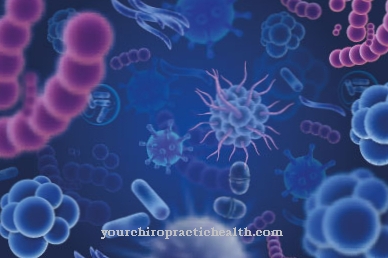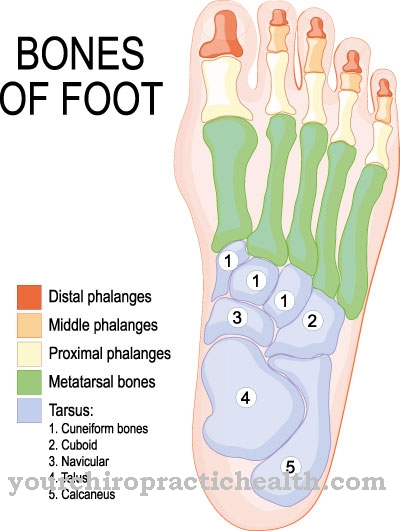Neurology is one of the most multifaceted and fascinating areas of medicine. In addition to diseases such as multiple sclerosis, Alzheimer's disease and the well-known stroke, there are also those Spinocerebellar ataxias of immense importance. These represent the generic term for a wide variety of disorders in the coordination of movements. The loss of nerve cells leads to a faulty interaction between the muscles.
What is spinocerebellar ataxia?

© designua - stock.adobe.com
Spinocerebellar ataxias (English: spinocerebellar ataxias, short: SCA) denote a group of neurodegenerative diseases of the central nervous system (CNS) in humans. The neurons (nerve cells) of the cerebellum (cerebellum) and the spinal cord (medulla spinalis) gradually perish. Diseases of this type are extremely rare; they occur in the USA and Central Europe with an average frequency of one new disease for every one hundred thousand people.
causes
The cause lies in the death of the Purkinje cells (the largest neurons in the cerebellum) due to the autosomal dominant inheritance of pathological genes. More than twenty-five different gene locations are currently known. The subgroups of spinocerebellar ataxia are defined according to these triggering genes and referred to as SCA type 1, type 2, type 3, or SCA1, SCA2, SCA3 et cetera.
Types 1, 2, 6, 7 and 17 belong to the group of trinucleotide diseases (such as Huntington's disease), as the disease is caused by a mutation in the form of an unusually long triplet repeat (triplet = three successive nucleobases of a nucleic acid) of the codon CAG (what corresponds to the amino acid glutamine). Spinocerebellar ataxia type 3 (SCA3), also known as Machado-Joseph disease (MJD), is the most common form of this disease in Germany, accounting for thirty-five percent of autosomal dominant inherited cerebellar ataxias.
Symptoms, ailments and signs
In most cases, the onset of the disease is between the ages of thirty and forty. The cardinal symptom is the coordination disorder of movement sequences (ataxia). Patients complain of the resulting unsteadiness when walking and standing, as well as clumsily grasping objects.
In addition, there is a change in the melody of speech (dysarthria) and a movement disorder of the eyes (nystagmus). Depending on the subgroups of spinocerebellar ataxia, there are also symptoms that occur depending on the involvement of other brain regions, for example muscle cramps, spasticity (pathological increase in muscle tone).
Also memory disorders (dementia), sensory disorders and abnormal sensations, swallowing disorders, incontinence, deterioration of vision, slowing of movement sequences and restless legs (restless legs syndrome). Some patients have Parkinson's-like symptoms that respond well to drugs used to treat Parkinson's disease.
Diagnosis & course of disease
The diagnosis is made on the basis of the detailed anamnesis, clinical-neurological examinations and additional findings (e.g. CSF examination, magnetic resonance imaging and neurophysiological examination) in order to rule out other possible diseases. A molecular genetic examination is urgently needed to confirm the diagnosis.
It is often difficult, sometimes impossible, to determine what type of ataxia is present because they are only slightly different. As the disease progresses, symptoms increase until the disease leads to death (in most cases).
Complications
Spinocerebellar ataxias can cause various complications, depending on the form of the disease. In general, ataxias lead to muscle spasms, spastic jerks, and changes in the melody of speech. In addition, memory disorders can occur, which can develop into dementia as the disease progresses.
The slowing down of movement sequences often represents a considerable restriction in everyday life for those affected. In connection with other complications, such as the typical deterioration in vision, ataxia sometimes also causes emotional distress. Regardless of the form of the disease, the symptoms increase as the disease progresses. In most cases, spinocerebellar ataxias result in death of the patient. Treating a neurological disorder also carries risks.
Drug therapy is always associated with certain side effects and interactions for those affected. The same applies to occupational therapy and physiotherapy, which are occasionally associated with tension, sore muscles and minor injuries. Surgical interventions are rare in spin rebellious ataxias, but can lead to infections, bleeding, secondary bleeding, infections and impaired wound healing. If the procedure goes badly, the original disorder may worsen.
When should you go to the doctor?
As a rule, with this disease, the patient is always dependent on medical treatment from a doctor. Above all, an early diagnosis with early treatment has a very positive effect on the further course. This is the only way to prevent further complications, as this disease cannot heal itself.
A doctor should be consulted if the affected person experiences problems with movement and coordination. As a rule, patients cannot easily walk straight or reach for things properly. Cramps in the muscles or spasticity can also indicate this disease. Many of those affected also suffer from difficulty swallowing or even from incontinence and other abnormal sensations.
The disease can be detected by a general practitioner. For further treatment, however, a visit to a specialist is usually necessary. Nor can it be universally predicted whether a complete cure can occur.
Treatment & Therapy
A causal therapy for spinocerebellar ataxias is not yet known. The focus is on symptomatic treatment in the sense of functional maintenance in order to preserve the patient's quality of life for as long as possible. These include medication, occupational therapy and physiotherapy, as well as speech therapy.
According to the German Society for Neurology (DGN), a pilot study showed that cerebellar ataxias respond to the active ingredient riluzole. Although research on spinocerebellar ataxias has been intensified in recent years, it is currently not so far advanced that a curative therapy can be expected in the near future.
In occupational therapy and physiotherapy, the mobility of the individual body sections is preserved, dwindling muscles strengthened and the formation of synapses is stimulated. The activities of daily living are practiced in order to maintain the patient's independence as much as possible. Speech therapy works on existing language problems.
prevention
Since it is a genetic disease, any kind of prevention is impossible.
Aftercare
The collective term 'spinocerebellar ataxia' describes genetically determined clinical pictures in which the nervous system is affected. Disturbed motor processes through to dementia in the late stage are typical symptoms. In contrast to other hereditary diseases, the symptoms do not only occur in childhood. The ataxia breaks out on average between 30 and 40 years of age, and in some patients earlier or not until they are 50 to 60 years old. Up to this point in time, the patient was symptom-free.
As things stand, spinocerebellar ataxia cannot be cured. The disease is chronic and in any case has a fatal outcome. Follow-up care is to alleviate symptoms and enable the patient to lead a largely normal life. A parallel, psychotherapeutic accompaniment is useful for the person concerned, since the illness can be associated with emotional stress.
Relatives also have the option of receiving support from a psychotherapist. The exercises should maintain the mobility of the limbs. If the language center is affected by the neurological failures, speech therapy therapies are recommended. The follow-up measures are long-term, they accompany the patient from the outbreak to the late stage of the disease. Follow-up care only makes sense if it has been carried out consistently for years.
You can do that yourself
In spinocerebellar ataxia, the focus is on medical and physiotherapeutic treatment. In addition, patients can do a few things to make everyday life easier with the disease.
The coordination disorder significantly restricts those affected in everyday life. Therefore, the most important measure is to compensate for the restrictions and to support the sick person as well as possible. In most cases, it is necessary to move to an apartment suitable for the disabled. The increasing movement restrictions also require a walking aid for the patient. Affected people need support in everyday life, as even simple activities can usually no longer be carried out without outside help. Sufferers should read specialist literature on spinocerebellar ataxia to better understand and accept the disease.
In addition, discussions with other affected persons are recommended, for example within the framework of a self-help group for people with Parkinson's. In the later stages of the disease, outpatient and finally inpatient care is necessary. In the final stages of the disease, when movements and conversations become increasingly difficult, comprehensive therapeutic care for the patient and his relatives can also be useful.


.jpg)


.jpg)







.jpg)

.jpg)
.jpg)











.jpg)